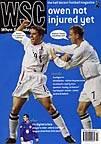 The drug money has dried up, but Nacional of Medellín are back – to the despair of their popular but inept neighbours. Jake Lagnado reports
The drug money has dried up, but Nacional of Medellín are back – to the despair of their popular but inept neighbours. Jake Lagnado reports
Hear the word Medellín and you might think of Pablo Escobar and the Medellín Cartel. Indeed, in Medellín, as in the rest of Colombia, there were many financial and personal ties between the drugs trade and professional football, as symbolised by the campaign to free the city’s favourite son, Rene Higuita, from jail in 1993. Since Escobar’s death the same year, the trade has been reorganised: much less drug money is invested in the local economy, meaning football clubs now have to market themselves to avoid total ruin.
But Medellín was a footballing town both before and after the goldrush. And this year the long-awaited revival of Atlético Nacional and the crisis over at struggling Deportivo Independiente Medellín have been the talk of Colombian football. Nacional epitomise the good times when narcotics money kickstarted the local economy. In 1989, they became the only Colombian team to win South America’s main club competition, the Copa Libertadores. And, even more importantly, they provided the backbone of Colombia’s best ever national squad – including Andrés Escobar, Leonel Alvarez, Faustino Asprilla, Freddie Rincón and Higuita, as well as manager Francisco Maturana. But since then their triumphs have been limited to winning the national title just twice and losing one Copa Libertadores final: a poor return for a club backed by some of the country’s wealthiest businessmen.
XThis year that could all change. Nacional are currently among the favourites to win the first championship of 2002 (the Colombian league has recently switched to the Argentinian system of having two championships in the year). Fans are pleased by the club’s promise – unique among Colombian clubs – not to hire any foreigners this year. The last two were hounded out following last year’s dismal showing. But this season’s tactics have also marked a break with the stylish but ultimately ineffectual football of old, leaving a residue of discontent among fans.
If Nacional are associated with wealth and success, the stereotype of Medellín and their fans is the opposite. As Nacional fans joke: “You know when Medellín are playing away, because everyone leaves their front doors open.” They are the equipo del pueblo, the people’s team, ridiculed for not having won a championship in 41 years. If Nacional symbolise ordinary people’s attempts to escape poverty, represented by the cartel in the Eighties and early Nineties, Medellín could be said to embody the harsh reality of life for most of the city’s inhabitants, particularly after the violent end of the boom period. And yet Medellín’s supporters are recognised as being the most loyal and fanatical in the whole country.
Historically, Medellín’s current poor form is pretty much par for the course. But in recent terms it is bitterly disappointing, because in December they were pipped to the title by America of Cali. With much of last year’s squad intact, fans hoped the team would carry on from where they left off. But it was not to be. Players were reputedly peeved at the directors’decision to use the proceeds of last year’s success to tackle the club’s debts rather than giving them the kind of pay rise they deserved. The confusion created by the protracted and ultimately aborted sale of top scorer Horacio Serna to Italy’s Serie A – he was given a rousing send-off at his final match, only to return weeks later – did not help.
Football clubs in Colombia have always had their barras: groups of supporters, often neighbourhood-based, who sit together with their own banners at every home match and arrange coaches to away games. But over the past few years new barras have emerged in Medellín. The Resistencia Roja (Red Resistance) of Medellín can number up to 15,000 on a good day. In the city they have waged an unrelenting and ubiquitous grafitti war with their rivals, Nacional’s Los Del Sur (The South Enders). Occasionally things have got worse. In March, a young fan and a police conscript died in trouble at a metro station after a local derby.
Worryingly, this rivalry could adopt political overtones as the civil war intensifies between guerrillas on one side, and the army, the US and rightwing paramilitary groups on the other. In recent years the paramilitaries have taken over much of the drug trade, ploughing the proceeds into the war, for which they have recruited heavily among Medellín’s youth.
On a national level, the paramilitaries have stopped and “disciplined” coachloads of away fans for “anti-social behaviour”. Barras in the capital Bogotá claim to have received threats because of their alleged leftwing leanings. It is to be hoped that the “total war” currently being preached and practised with gusto in Colombia following the breakdown of peace talks between the guerrillas and the government does not extend its tentacles any further into football.
From WSC 185 July 2002. What was happening this month